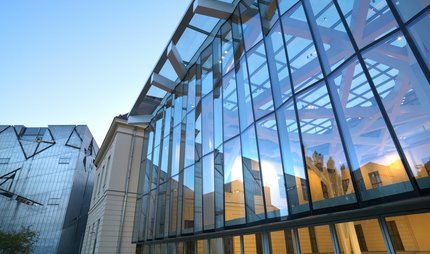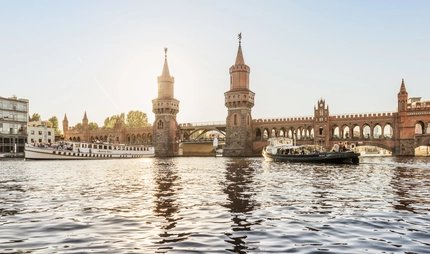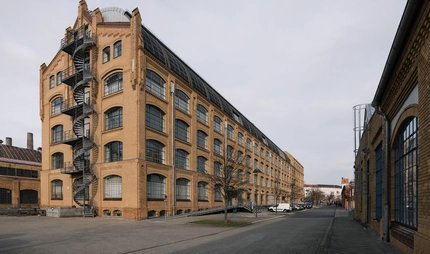
Haus des Deutschen Metallarbeiterverbandes (The House of the German Steelworkers Union)
Demonstrator with the flag in his hand
Modern, dynamic, combative – this is what the German Steelworkers Union wished for its new headquarters.
With the House of the German Steelworkers Union, architect Erich Mendelsohn designed an outstanding example of Neues Bauen from 1929 to 1930. It not only served as the trade union’s headquarters, but was also intended to symbolise their socio-political commitment. It has a curved façade at the front of the elongated building complex and the flag pole with the trade union flag above the main façade is in the form of a demonstrator at the head of a protest march.
Mendelsohn was a successful architect in the 1920s. He had 40 employees working for him and clients such as trade unions and companies lining up. You can see just how modern the House of the German Steelworkers Union is if you walk a few steps further to the corner of Gitschiner Strasse/Lindenstrasse. There you will find the former Kaiserliche Patentamt (Imperial Patent Office), a building in the style of the German Empire decorated with an historicist façade.
Carefully emphasizing the horizontal
The House of the German Steelworkers Union is a work of New Objectivity. It didn’t have any ornamentation or historical allusions, but was made using a new building technique. A steel skeleton supported the building complex but it was not just functional. Thanks to the steel girders, Mendelsohn was able to freely design the façades and indulge his preference for expressive buildings: with the concave, inward-curving main façade, for example.
Mendelsohn filled it with huge strips of windows, some of which wrapped around the corners. The windows drew horizontal lines across the building, which was by no means a coincidence. Mendelsohn used the horizontal as a remedy against the stress of modern living:
“The man of our times can only find respite from the excitement of his brisk life in the relaxed horizontal.”
To underscore the impact of the trade union headquarters, Mendelsohn used high-quality materials: the exterior cladding was made of travertine limestone, just like the Shell-Haus (Shell House) on Reichpietschufer, which was built at the same time. The architect used bronze for the door and window surrounds. At the front end of the building he installed an elegantly curved spiral staircase. Its importance was underlined by the above-average height of the first floor, which also housed the conference hall and could be seen from outside through a large glass front.

Sudden demise and a new beginning
The Steelworkers Union inaugurated its new headquarters in 1930. It was delayed because the construction workers went on strike against the union for weeks. During the Weimar Republic, the communist-minded workers and pro-SPD trade unions were adversaries.
The real danger, however, came from the right: after the Nazis came into power in 1933, they banned the trade unions. Three years after its opening, the House of the German Steelworkers Union became the headquarters of the Nazi German Labour Front.
And the architect? Mendelsohn had to go into exile in 1933. He worked in England, then travelled to Palestine in 1934. In 1941, he emigrated to the United States. Ernst Sagebiel, Mendelsohn’s construction manager at the House of the German Steelworkers Union, headed in the opposite direction: he joined the NSDAP (National Socialist German Workers Party) and built barracks and Tempelhof Airport for the new regime.
The House of the German Steelworkers Union was bombed during the Second World War and almost completely burnt down in 1945. IG Metall restored the building from 1948 to 1952. Extensive historically-accurate restoration work was performed in 1989.
Today, the building almost looks like it did in 1930. It is still a trade union building and the headquarters of the IG Metall District Management for Berlin, Brandenburg and Saxony.
Our tips for the House of the German Steelworkers Union
You can discover further Berlin Modernism attractions in the surrounding area by bus. At the Zossener Brücke bus stop, take line 248 towards Stralauer Platz. In a few minutes you will reach the Jewish Museum. Only a few steps away you will find the Berlinische Galerie, the State Museum of Modern Art, Photography and Architecture, and opposite in a Max-Taut building the Tiyatrom Theatre, which has performances in German and Turkish.
Please note: The Berlinische Galerie is closed until 25 May. The lighting system of the rooms is being modernised.
Practical information from visitBerlin
You can get to the House of the German Steelworkers Union from Warschauer Strasse or Kurfürstendamm by taking U-Bahn line 1 to the Hallesches Tor U-Bahn station. To explore the city by public transport, we recommend the Berlin WelcomeCard.



